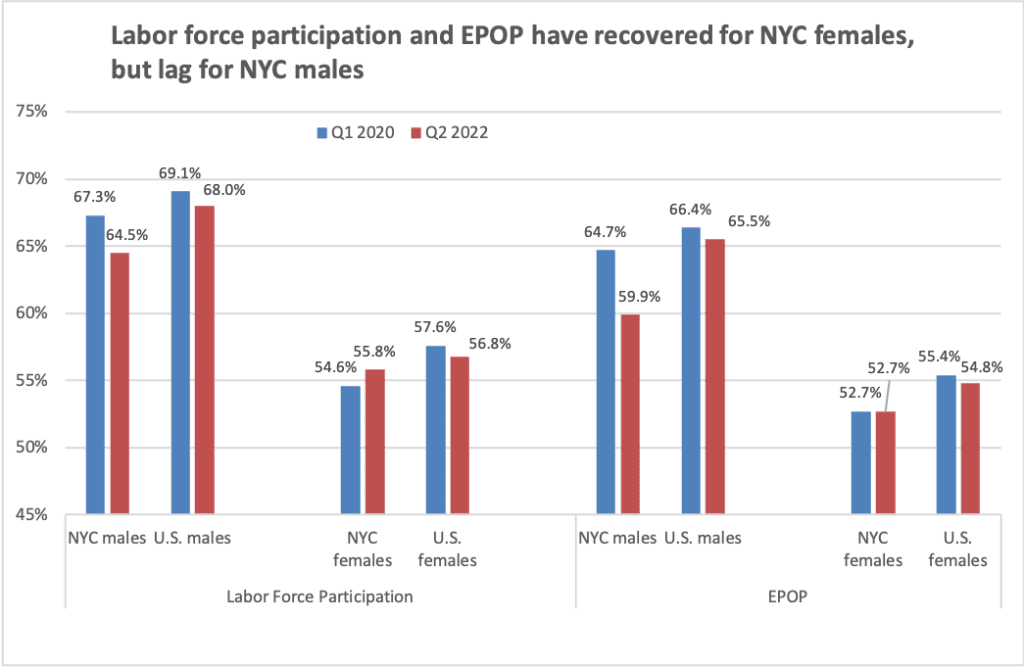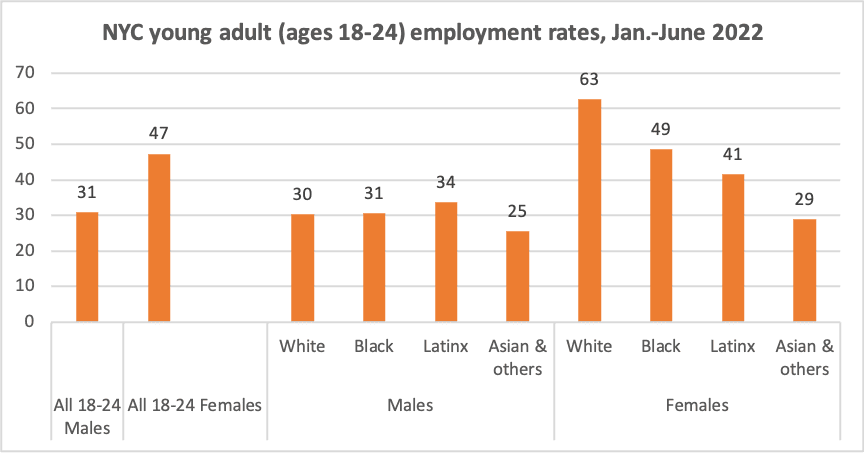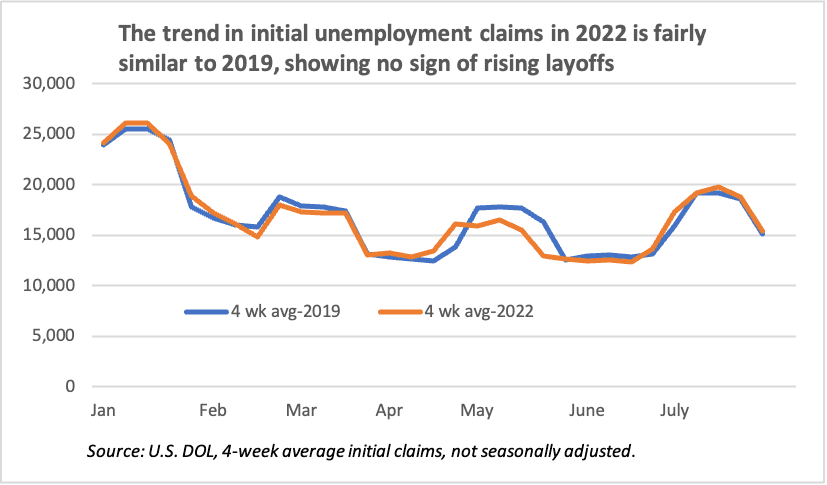While unemployment remains much higher than the national average, labor force participation and employment rates have recovered for the city’s women workers but not for men; the employment rate for young men was only 31 percent for the first half of 2022.
COVID-19 Economic Update is part of a regular biweekly Covid-19 Economic Update series. This week’s update was prepared by Lina Moe and James Parrott, Center for New York City Affairs at The New School. Read past installments here.
New York City’s unemployment rate for the second quarter (April-June 2022) fell to 6.2 percent from seven percent in the first quarter. However, this remains nearly double the U.S. overall unemployment rate, which was 3.6 percent in the second quarter and fell to 3.5 percent in July. The city’s pre-pandemic unemployment rate was 3.7 percent in the first quarter of 2020 (seasonally adjusted), about the same as for the nation overall.
Unemployment is higher for New York City’s men (7.1 percent) than for women (5.4 percent). This is a reversal from earlier in the year, with unemployment rising for men between the first and second quarters (up from 6.7 percent), while it fell for women (down from 7.3 percent in the first quarter).
As we have noted previously, there is a wide disparity in the unemployment rate by race and ethnicity in New York City. In the latest quarter, unemployment is much higher for Black New Yorkers (10.8 percent) than for White workers in New York (3.2 percent), with Latinx and Asian workers in between (6.5 and 6.4 percent, respectively). White workers also experienced the largest unemployment decline between the first and second quarters of this year, with their unemployment dropping from 5.4 percent to 3.2 percent. Latinx workers saw a smaller decline from 7.5 percent to 6.9 percent, and Black workers saw a slight improvement from 11 percent to 10.8 percent. Unemployment rose for Asian and other workers, from 5.2 percent to 6.4 percent in the second quarter.
While women who assumed the bulk of care-giving responsibilities faced great challenges during the first two years of the pandemic, by the second quarter of this year labor force participation for New York City’s women topped the pre-pandemic level from the first quarter of 2020, and their employment rate (or EPOP) equaled the per-pandemic level. Nationally, women have not quite regained all the labor market ground, with labor force participation eight-tenths of a percentage point behind the pre-pandemic quarter and the employment rate six-tenths of a percentage point lower in this year’s second quarter compared to the first quarter of 2020. (See the chart below.)

On the other hand, these critical labor force indicators are far from having recovered for New York City’s men. The labor force participation rate for the city’s men was 2.8 percentage points lower in the second quarter of this year than in the first quarter of 2020 (64.5 percent vs. 67.3 percent), while the employment rate for the city’s males was 4.8 percentage points below the pre-pandemic quarter (59.9 percent vs. 64.7 percent). Although these measures are also below pre-pandemic levels for all males nationally, the differences are only about a percentage point, much less than the shortfall for New York City’s males.
The pandemic has been particularly challenging for parents of young children, especially for primary caregivers. Women (ages 25-44) make up about one-quarter of the city’s resident labor force, nearly one million workers. While throughout the pandemic, women – particularly women of childbearing age – left the workforce in sizable numbers, this trend now appears to have reversed course. The recovery in labor force participation and employment rate noted above for women overall in New York City hold also for women ages 25-44. Improvements between the first and second quarters of this year now put these labor force rates slightly above pre-pandemic levels. The unemployment rate for women 25-44, however, is still higher (4.9 percent) than in the pre-pandemic first quarter of 2020 (3.4 percent.)
While we don’t have a definitive analysis to explain the apparent labor market recovery for women 25-44, it is likely that a combination of factors, including falling Covid-19 infection rates, the stabilization of childcare access, and economic need related to rising inflation or the end of the child tax credit, could be providing both push and pull factors for women to be re-entering the labor force.
A second-quarter update on the young adult male employment rate
Our recent economic update revealed that young adults have nearly three times the rate of unemployment as the city’s workforce overall. Concentrated heavily in face-to-face industries, like retail, and leisure and hospitality, these younger workers (ages 18-24) make up about nine percent of the city’s overall workforce (approximately 360,000 workers). Averaging the numbers from the first and second quarters of this year to improve data reliability, the unemployment rate for young males was nearly twice that for young females (27 percent vs. 14 percent). The young male employment rate fell further in the second quarter and averaged 31 percent for the first half of 2022 (it was 56 percent before the pandemic).
The chart below separates the employment rate by gender and race/ethnicity for the first six months of 2022. Employment rates for young males are uniformly low across the racial/ethnic groups, while there is greater variation among females, e.g., with an employment rate of 63 percent for white females 18-24 more than double the 29 percent rate for young Asian females.

No sign yet of rising layoffs
While the national jobs report for July showed a sizable 528,000-worker employment gain, there is some concern that the economy might be heading into a recession. This arises in part from data showing that the Gross National Product, the broadest measure of economic output, slipped in the first two quarters of this year, as well as from measures of consumer confidence or expectations, which have weakened in recent months. The July employment report for New York City and State will come out later this week and will provide an indication of whether job growth continues to hold up locally.
Another indicator shedding light on employment trends is initial unemployment claims, weekly data that indicates the extent of layoffs or of people losing their jobs for another reason. The chart below shows that initial unemployment claims filings in New York State through the first seven months of this year are fairly similar to the pre-pandemic trend in 2019. Thus, so far there is no hint of economic slowing in the New York unemployment claims data, which is often seen as a leading indicator of recession.

# # #
